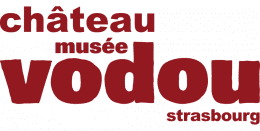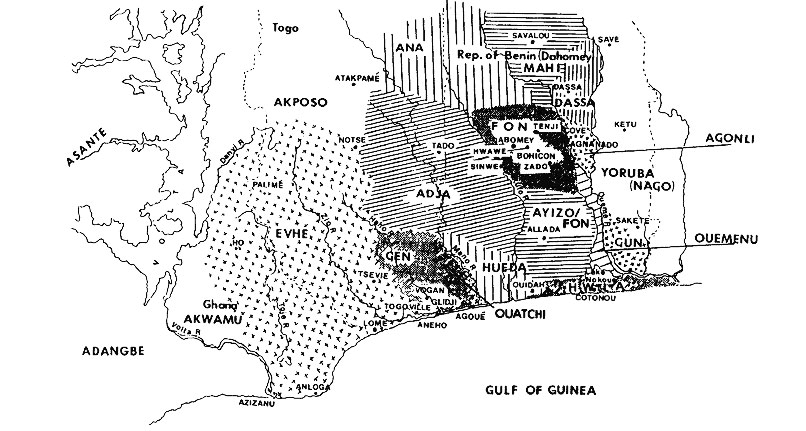The collection
The Arbogast collection of Vodou artefacts
This museum hosts a collection that is unique, both by its size and its content. It belongs to Marie Luce and Marc Arbogast.
Marc and Marie Luce have assembled a collection of more than 1000 vodou objects, 220 of which make up the permanent exhibition “Vodou: the art of seeing differently”.
The vodou
Vodou: a wealth of gods and symbols
When they hear the word “Vodou”, most people tend to think of Voodoo as it is portrayed in Hollywood films, with celebrants falling into atrance, zombies, and effigies pierced with needles – as opposed to what it truly is, a belief system shared by millions of people worldwide.
Vodou is present not only in West Africa, where it originated, but also in North America, South America, and in the Caribbean, having been brought by African slaves to the New World. It is also represented in Europe, through migratory flows in the 20th century. Vodou is a religion as well as a philosophy of life, and encompasses a wide range of beliefs and practises.
In Vodou, this world and the invisible world are indissolubly linked. Mankind depends on this other world, which is peopled by ancestors, spirits, gods, and other forces that influence people’s lives. Every Vodou legend can be said to begin with a catastrophe: all the crises, diseases, deaths, wars and other disasters that affect mankind originate in this parallel world. In this regard, Vodou provides an explanation for misfortunes ranging from a failed exam to violent death; these can be interpreted as a message from the beyond. Through Fa divination, mankind can communicate with the vast pantheon of Vodou deities (there are an estimated 300 deities), all of whom are devious, prickly, jealous, vain and conceited. In short, these gods hold a mirror up to mankind.
Ritual, music, and dancing are used to communicate with the invisible world; and so too are objects, made from materials as diverse as wood, packaging, sticks, horns or bottles filled with herbs, recycled kitchen utensils, unidentifiable agglomerations of matter, sundry elements sewn, strung, or tied together. Marc Arbogast’s remarkable collection of Vodou artefacts conveys many private and collective tales about people’s lives, past and present. Over the past thirty years, he collected nearly one thousand such artefacts in Nigeria, Benin, Togo and Ghana; and these have now found their way to the Château Vodou in Strasbourg.
Vodou geography
Vodou resulted from the encounter between Yoruba, Fon and Ewe religions. It crystallized in its present form around the 17th century with the birth and expansion of the Fon kingdom of Abomey. It underpins the Aja-Tado culture, born of several successive migratory waves. The Aja-Tado cultural area ranges from the Ouémé river in the east to the Volta in the west and the so-called Slave Coast in the south. It covers an area 200 to 300 km deep between 0º and 3º longitude, in the heart of what geographers term the Sudanese savanna.
This area is peopled mostly by the following ethnic groups:
The ADJA (AJA) people in the area between Yoto in Togo and the Kouffo in Benin
The EVE (EWE) in the area between the Volta and Yoto
The FON (FON) in the area between the Ouémé and the Kouffo
The GUIN (GÊ) along the so-called Slave Coast
The XWLA and XWÉDA in roughly the same area as the Gê
The GOUN (GUN) in and around the city of Porto-Novo
The AIZO (AYIZO) around lake Nokoué, and around the Allada region
The SAHWÉ in the black lands of Ko in the Bopa region
During the reign of King Agaja (1708 – 1740), Dahomey expanded southwards towards the Atlantic coast, after the conquest of Allada (1724) and Whydah (1727). Its sphere of influence stretched from the borders of the Oyo empire (Nigeria) to those of the Ashanti kingdom (Ghana).
This part of Africa was in contact with European and North African cultures, which explains why Vodou incorporated elements of Christianity, Islam and Judaism.
From the outset, Vodou was a holistic and syncretic religion, reflecting the societies that gave birth to it.
Origins
Spelled “Vodou,” “Vaudou,” “Vodoun,” “Voudou,” and “Voodoo” in English, most likely mispronounced and misspelled by colonists, the term comes from the word “Vodoun,” which means “that which cannot be elucidated, power, that which is efficient” in the Fon language. It carries with it notions of invisibility.
“Vodou religious belief posits the existence of an extramundane world. This ineffable sphere of being gave rise to the primeval couple, Mawu/Lisa. Significantly, it is the female principle who is the progenitor; therefore Mawu is the main protagonist, rather than her male counterpart (Lisa). However, this concept of a supreme being differs from Western notions of a creator deity responsible for shaping the world and mankind.
In Vodou legend, Mawu and Lisa merely beget the first vodoun deities governing the elements and the human spirit. That is the extent of their role, and Vodou theology does not deal with the complex matter of creation. The process of creation appears to be compartmentalized. Besides the dual Mawu/Lisa, we also find Fa (speech and meaning) and Gbadu (absolute knowledge). In some legends these entities derive from Mawu/Lisa; in others, they are said to predate them, or even to beget them. This contradiction is due to the fact that the concept of Fa originates in another tradition, and was incorporated into the Vodou belief system in the guise of a deity.” (excerpt from the forthcoming book La Fabrique des Dieux by René de Beaumont)

